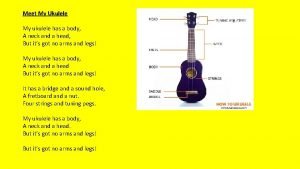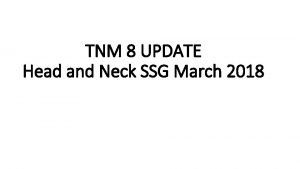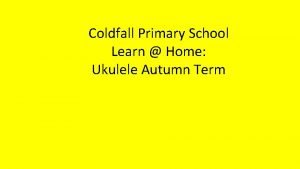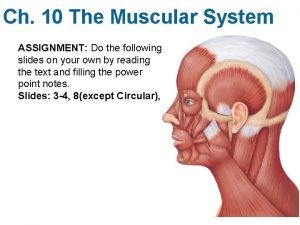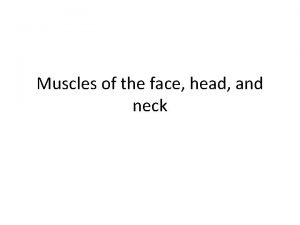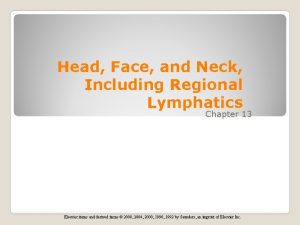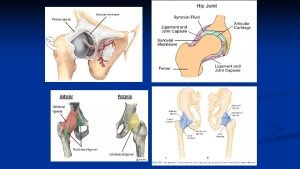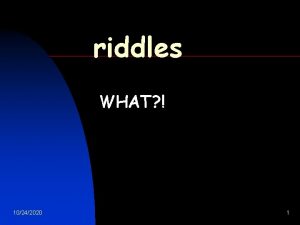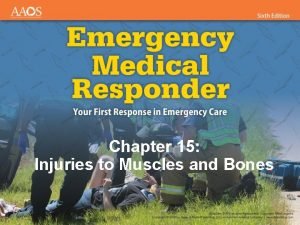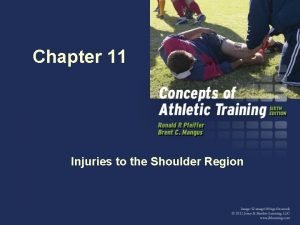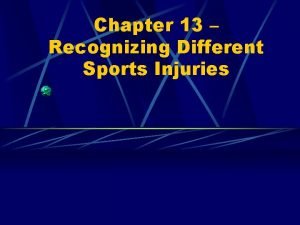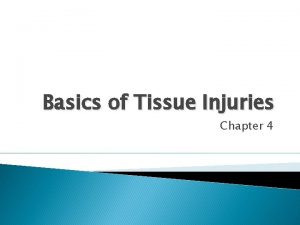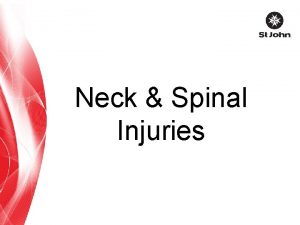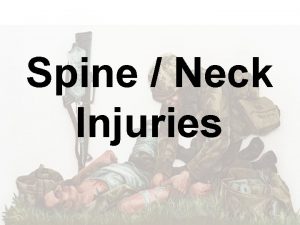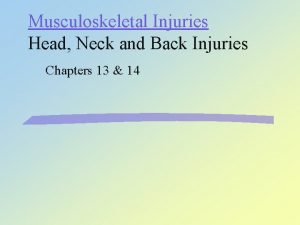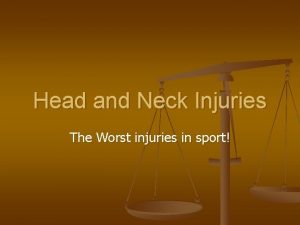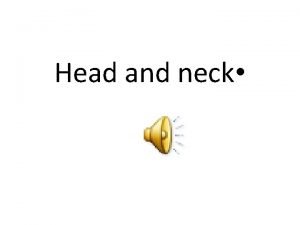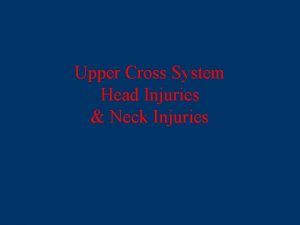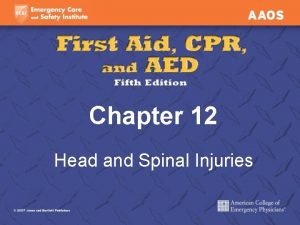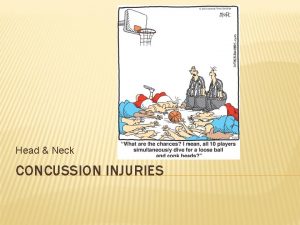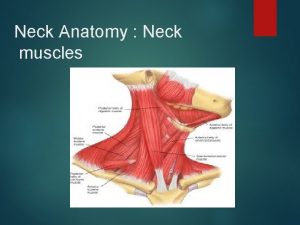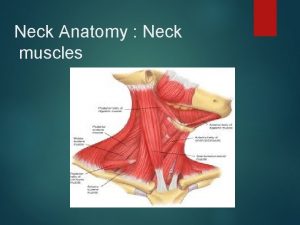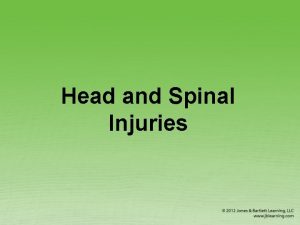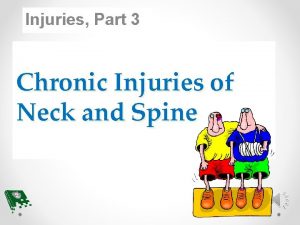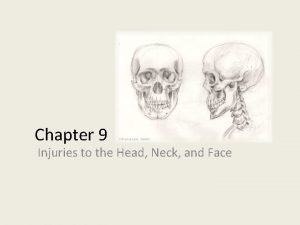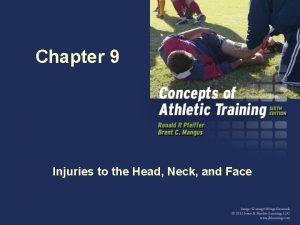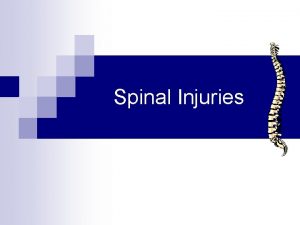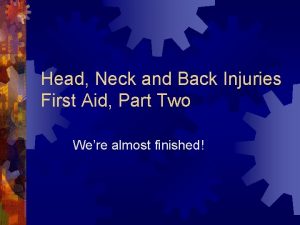Chapter 9 Injuries to the Head Neck and

























- Slides: 25

Chapter 9 Injuries to the Head, Neck, and Face

Anatomy Review Skull • The skull has 9 cranial bones & 2 major boney process. • Cranial bones have articulations called suture joints.

Central Nervous System (CNS) • Brain (encephalon) and spinal cord compose the CNS. • CNS is protected by meninges, cranium, and vertebrae. • CNS consists of gray and white matter and weighs 3 to 3. 5 lbs (adult). • Brain has three basic components – cerebrum, cerebellum, and brain stem. • Neural impulses travel to and from the CNS via 12 pairs of cranial nerves and 31 pairs of spinal nerves.

Brain Anatomy • Cerebrum is the largest section of the brain. • Consists of a left and right hemisphere. • Cerebellum is the small section located in the posterior section of the skull. • Latin for “little brain” • Brain stem is the bottommost portion of the brain • Connects the spinal cord to the brain

Meninges The Meninges • Located underneath cranial bones, consisting the dura mater, arachnoid, and pia mater.

Meninges (cont. ) • Dura mater is dense and highly vascularized. • Arachnoid (middle layer) is less dense and avascular. • Sub-arachnoid space contains cerebrospinal fluid (CSF). CSF cushions the brain and spinal cord from external forces. • Pia mater (innermost layer) is thin, delicate, and highly vascularized.

The Face • The face is composed of skin placed over underlying bones. - Subcutaneous muscles, cartilage, and fat provide minor protection. • Several areas of the face are prone to injury, particularly orbits of the eyes, nasal bones, and mandible.

The Neck (cervical spine) • The 7 cervical vertebrae provide support for the head and protection for the spinal cord.

The Neck (cont. ) • The first cervical vertebra (C-1) is called the atlas. • The atlas articulates with the occipital bone to form R and L atlanto-occipital joints. • The second cervical vertebra (C-2) is called the axis. • The skull and C-1 articulate as a unit with C-2 to form the atlantoaxial joint.

Head Injuries in Sports Even minor head trauma can result in serious injury. • Brain tissue is unable to repair itself. • Any tissue loss results in some level of permanent disability. • Severe injuries can result in death. • Coaches can learn to recognize head injuries and render first aid when necessary.

Mechanisms of Head Injury Direct mechanism of injury involves a blow to the head that causes injury at impact site (coup injury) or on the opposite side of the skull from impact (contracoup injury). Indirect injury to the head results from damaging forces traveling from other parts of the body. Treat every head injury as if there is a neck injury and vice versa.

Concussions A concussion is “a clinical syndrome characterized by immediate and transient impairment of neurologic function secondary to mechanical forces. ” • NCAA defines a concussion as: • An injury to the brain • Caused by a direct or indirect blow • Resulting in impaired function and time out of activities

Concussion Signs and Symptoms

Concussions (cont. ) Cantu classification (obsolete) • Grade 1 (mild) involves no amnesia but are difficult to identify. • Grade 2 (moderate) involves loss of consciousness for less than 1 minute and/or PTA lasting longer than 30 minutes. • Grade 3 (severe) involves loss of consciousness for more than a minute and PTA lasting more than 24 hours.

Second Impact Syndrome (SIS) can be a serious problem. • Results when an athlete with a head injury receives another head injury before the symptoms of the initial injury have resolved. • Involves rapid, catastrophic brain swelling. • SIS can result in death. Any athlete sustaining a head injury, no matter how minor, should be referred to a physician before being cleared to return to participation.

Head Injuries in Sports Cranial injury: • Involves the bones of the skull. • May also have associated soft tissue injury. • More severe forms of cranial injury involve depressed skull fractures - Involves bone fragments being pushed into the cranial region.

Head Injuries in Sports (cont. ) Intracranial Injury: • These injuries are potentially life threatening. • Majority result from blunt trauma to the head. • Disruption of blood vessels results in intracranial bleeding (hematoma) and swelling within the cranium.

Intracranial Injuries Major forms of intracranial injury include: • Epidural hematoma. • Subdural hematoma. • Intracerebral hematoma. • Cerebral contusion. Epidural hematoma develops quickly due to arterial bleeding, while subdural hematoma develops slowly due to venous bleeding. Some degree of permanent neurologic damage and even death can result.

Initial Check Immobilize head and neck immediately; do not remove athlete’s helmet. Always assume a neck injury has also occurred. • Check vitals first. • Note body and limb positions, as well as helmet, face mask, and mouth guard positions. • If unconscious, attempt to arouse and note approx. time of injury.

Initial Check (cont. ) • If unconscious, detect breathing by: • Listening near the athlete’s face for typical breathing sounds. • Looking for movements of the thorax and/or abdomen. If no signs of circulation are present, begin CPR and summon EMS.

Physical Examination The physical exam must include assessments of: • Consciousness or unconsciousness. • Extremity strength (if conscious) without moving the neck. • Mental function (if conscious). • Eye signs and movements. • Neck pain. • Neck musculature spasm.

Physical Exam (cont. ) If head injury is suspected: • Do NOT remove helmet. • Do NOT move the athlete. • Do NOT use ammonia capsules to revive athlete. • Do NOT rush through physical exam.

Physical Exam (cont. ) If athlete is conscious: • Perform grip strength tests. • Check bilateral strength by asking athlete to dorsiflex feet. • Check for sensations on both sides of body by pinch tests. • Monitor athlete’s eyes by checking pupil sizes and response to light, and eyes’ ability to follow moving object side to side. • Note loss of peripheral vision or jerking eyeball movements. • Palpate neck for deformity, moving from base of skull to bottom of neck.

Physical Exam (cont. ) Based on these observations, determine level of consciousness. • Athlete with grade 1 concussion should be able to walk with assistance. • Athlete with grade 2 or 3 concussion should not be moved. • Monitor vital signs. • Summon EMS. Any athlete with a concussion should be removed from field of play and examined by a physician.

Quick Neurological Tests Finger-to-Nose Test Courtesy of Ron Pfeiffer Romberg’s Test
 Chapter 28 head and spine injuries
Chapter 28 head and spine injuries Chapter 21 caring for head and spine injuries
Chapter 21 caring for head and spine injuries Meet my ukulele song
Meet my ukulele song Tnm 8 head and neck
Tnm 8 head and neck Risk factors of head and neck cancer
Risk factors of head and neck cancer This is home ukulele
This is home ukulele Muscular system assignment
Muscular system assignment Function of muscles
Function of muscles Regional write up head face and neck
Regional write up head face and neck Fractuer
Fractuer What has a neck but no head
What has a neck but no head Chapter 15 injuries to muscles and bones
Chapter 15 injuries to muscles and bones Chapter 14:2 preventing accidents and injuries
Chapter 14:2 preventing accidents and injuries Jones and bartlett learning
Jones and bartlett learning Chapter 13:2 preventing accidents and injuries
Chapter 13:2 preventing accidents and injuries Chapter 11 assessment and evaluation of sports injuries
Chapter 11 assessment and evaluation of sports injuries Chapter 12 lesson 2 improving your fitness
Chapter 12 lesson 2 improving your fitness Chapter 17:8 providing first aid for cold exposure
Chapter 17:8 providing first aid for cold exposure Chapter 11 injuries to the shoulder region
Chapter 11 injuries to the shoulder region Chapter 4 preventing injuries through fitness
Chapter 4 preventing injuries through fitness Chapter 13 worksheet recognizing different sports injuries
Chapter 13 worksheet recognizing different sports injuries Chapter 4 basics of tissue injuries
Chapter 4 basics of tissue injuries Indexing head parts
Indexing head parts Suction lift
Suction lift The attacking firm goes head-to-head with its competitor.
The attacking firm goes head-to-head with its competitor.


